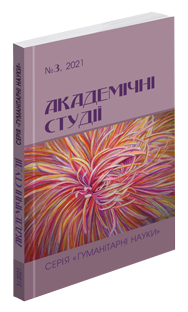Abstract
The linguistic research deals with the analysis of semantics of slogans in German speech in 2015 as a part of advertising text. The semantics of the slogans reflects the technical, cultural, economic, ecological and social experience of the ethnos, which is constantly renovated, expanded, changed. It is show that the slogan is a creative product of language and thinking. It informs about the quality of a brand, product or service and at the same time directs this quality to a person (addressee), encouraging him (her) to act resolutely. The issue concerning etymology and dynamics of the notions “advertising” and “slogan” is covered. Tree stages of their semantic contents are distinguished. Policy, structure and graphic highlighting of advertising and slogan (color, size, and font) in the text s of the Focus journal 2015 are described. The main function – manipulation addressee is outlined. Special attention is paid to the classification of advertising texts and paradigm of semantic subtypes of slogans. The present study suggests classification of slogans according to two criteria: text semantics and localization in the periodical. Twelve semantic subtypes of the phenomenon and its three dispositions: initial, medial and final with dominance of the medial are identified. Technical vehicles, including native and foreign (America, Sweden) cars are currently of great interest for German linguistic community. Slogans of native cars are represented concisely and precisely, accordingly, foreign-obscurely. Native brands are focused on positive emotions such as: joy, surprise and appreciation, foreign ones are related only to the assessment of technical characteristics (America) and pragmatism (Sweden). The semantic subgroups “Services”, “Financing and Credit” hold the second place. “Services” are divided into three types: real, virtual, remote, “Financing and Credit” apply to banking institution, that compete with each other.
References
Воллюто. Кава для кавоварки, її види та корисні поради. URL: coffeerecept.pp.ua › kava-dlya-kav… [дата звернення: 22.12.2020]
Воронько-Невіднича Т. В., Калюжна Ю. П., Хурдей В. Д. Реклама і рекламна діяльність. Полтава : РВВ ПДАА, 2018. 230 с.
Котлер Ф. Основы маркетинга. Москва : Прогресс, 1991. 651 с.
Кухаренко В. А. Интерпретация текста. Москва : Просвещение, 1988. 192 с.
Миронова Н. Гипертекстовые технологии как основа нативной рекламы. Przegląd Wschodnieoeuropejski, ІХ/2, 2018. С. 209–217.
Морозова І. Б. «З’їж мене!»: слоган як ключовий елемент англомовного рекламного повідомлення. Актуальні проблеми романо-германської філології та прикладної лінгвістики. 2 (15), 2017. С. 67–72.
Скрицька Н. А. Реклама: до визначення поняття. Правове регулювання економіки. 9. 2009. С. 203–212.
Тонконог Н. Образні мовні засоби створення рекламних слоганів. Актуальні питання іноземної філології. № 9. 2018. С. 195–199.
Тресиддер Дж. Словарь символов. Москва : ФАИР-ПРЕСС, 2001. 448 с.
Kiklewicz A. Фрагментация текста как средство персуазивности в информационных интернет-сервисах. Przegląd Wschodnieoeuropejski, VIII/1, 2017. C. 185–205.
KLUGE. Etymologisches Wörterbuch der deutschen Sprache. Berlin: WdeG, 1999. 924 S.
Müller V. Das große deutsch-ukrainische Wörterbuch. Kyjiw: Tschumatzkyj Schljach Verlag, 2012. 792 S.
Paul H. Deutsches Wörterbuch. Tübingen: Max Niemeyer Verlag, 1992. 1130 S.
WAHRIG. Wörterbuch der deutschen Sprache. München: dtv, 2012. 1152 S.

